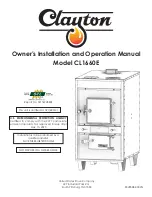
Form I-XE/CRGB/RPB, Mfg No. 131782 Rev 4, Page 41
FIGURE
46J -
Side
Filler
Panel
Installed
Attach side filler panel
with sheetmetal screws.
Cooling Coil
Cabinet with
Downturn Plenum
Furnace
Section
with Door
Panel
Removed
FIGURE 46K -
Top Filler Panel
Installed
Before the top filler panel is attached, remove the backing and
adhere the gasket strip along the bottom of the outside edge so
that any gaps between the top filler panel and the top panel of
the furnace section are sealed.
Filler must be underneath the top
panel.
Cooling Coil Maintenance
The cooling coil cabinet is designed with easily removable panels on both
sides of the cabinet to provide access for inspection and cleaning. Inspect
the coil during routine maintenance and whenever the filters are changed.
Check the cooling coil for build up of debris; clean as required.
8. Install the Cabinet Top Filler Panel (See FIGURE 46K)
a) Remove the backing from the gasket strip, and adhere it along
the edge of the bottom of the top filler panel.
b) Slide the filler panel underneath the edge of the cooling coil
cabinet top (NOTE: The edge of the top panel may have to
be pulled out slightly to slide the panel underneath.) The
filler panel must be between the cooling coil cabinet top
and end panel
to prevent water from leaking into the
cabinet. Attach with 1/2" screws.
MAINTENANCE AND SERVICE
WARNING: If you turn off the power supply, turn
off the gas. See Hazard Levels, page 2.
This unit will operate with a minimum of maintenance. To ensure long
life and satisfactory performance, a furnace that is operating under
normal conditions should be inspected every four months. If the fur-
nace is operating in an area where an unusual amount of dust or soot or
other impurities are present in the air, more frequent inspection is
recommended.
The following procedures should be carried out at least annually (See
Paragraphs 37-40 for specific instructions.):
Clean all dirt and grease from the primary and secondary combus-
tion air openings.
Check the gas valve to ensure that gas flow is being shutoff com-
pletely.
Clean the heat exchanger both internally and externally.
Check the pilot burner and main burners for scale, dust, or lint
accumulation. Clean as needed.
Check the vent system for soundness. Replace any parts that do
not appear sound.
Check the wiring for any damaged wire. Replace damaged wiring.
(See Paragraph 12 for replacement wiring requirements.)
NOTE: Use only factory-authorized replacement parts.
37. Operating Gas Valve
WARNING: The operating valve is the prime safety
shutoff. All gas supply lines must be free of dirt or
scale before connecting to the unit to ensure positive
closure. See Hazard Levels, page 2.
Remove external dirt accumulation and check wiring connections.
The combination gas valve must be checked annually to ensure that
the valve is shutting off gas flow completely.
9. Reinsert Screws and Apply Caulking
a) Reinsert any remaining screws removed in Step 5. Check for
gaps between the top and side filler panels; apply caulking as
needed.
b) Apply silicone caulking where the cooling cabinet curb cap
meets the furnace curb cap.
10.
The cooling coil cabinet is installed. Follow the instructions provided
by the cooling coil manufacturer to make cooling coil connections.
Instructions
:
1)
Locate the 1/8” FPT
INLET
pressure tap on the combination valve
(See
FIGURE 47
).
Single-Stage
Valve
Two-Stage
Valve
1/8" INLET
Pressure Tap
1/8”
Outlet
Pressure
Tap
1/8" INLET
Pressure Tap
1/8”
Outlet
Pressure
Tap
FIGURE 47
2)
With the manual valve turned off to prevent flow to the gas valve,
connect a manometer to the 1/8” inlet pressure tap in the valve.
NOTE:
A manometer (fluid-filled gauge) with an inches water
column scale is recommended.
3)
With the field-installed manual valve remaining closed, observe the
manometer for two to three minutes for an indication of gas
pressure. No pressure should be indicated on the manometer.
If the manometer indicates a gas pressure
, the field-installed
manual gas valve must be replaced or repaired before the combina-
tion gas valve can be checked.
4) If the manometer does not indicate gas pressure
, slowly open
the field-installed manual gas valve. After the manometer's indicated
gas pressure has reached equilibrium, close the manual shutoff valve.
Observe the gas pressure. There should be no loss of gas pressure
on the manometer. If the manometer indicates a loss of pressure,
replace the combination gas valve before placing the heater in
operation.
NOTE:
Operational pressure settings and instructions for checking pres-
sure settings are in Paragraph 11.




































